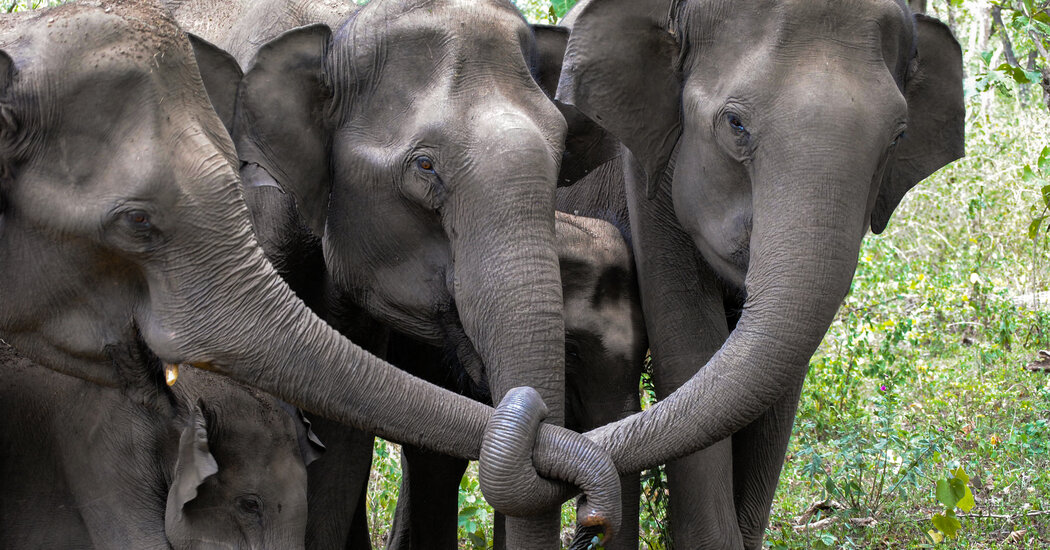It was 2013 when Sanjeeta Pokharel first saw Asian elephants react to death. An elderly female elephant in an Indian park had died of an infection. A younger woman walked in circles around the carcass. Fresh dung heaps indicated that other elephants had recently visited.
“We became curious there”, said Dr. Pokharel, a biologist at the Smithsonian Conservation Biology Institute. She and Nachiketha Sharma, a wildlife biologist at Kyoto University in Japan, wanted to know more. But it’s rare to see such a moment in person, as Asian elephants are elusive forest dwellers.
For an article published Wednesday in the journal Royal Society Open Science, the scientists used YouTube to crowdsource videos of Asian elephants responding to death. They found reactions such as touching and standing guard, as well as punching, kicking and shaking. In a few cases, females had even used their trunks to carry calves or baby elephants that had died.
The work is part of a growing field called comparative thanatology – the study of how different animals respond to death. African elephants appear to repeatedly visit and touch carcasses. But for Asian elephants, Dr. Pokharel: “There were stories about it, there was newspaper documentation, but there was no scientific documentation.”
When combing through YouTube, the researchers found 24 cases for study. Raman Sukumar of the Indian Institute of Science, a co-author, provided videos of an additional case.
The most common reactions were sniffing and touching. For example, many elephants touched the face or ears of a carcass with their trunks. Two young elephants used their paws to shake a dead specimen. In three cases, mothers repeatedly kicked their dying or dead calf.
Asian elephants also communicate with touch during life, said Dr. pokharel. They may sleep together or offer comforting torso touches. Younger elephants are often seen with their trunks entwined, she said.
Another common response to death was making noise. Elephants in the videos trumpeted, roared or rumbled. Often elephants kept some sort of vigil over a carcass: they stayed close, occasionally slept nearby, and sometimes tried to scare people who tried to investigate. Several tried to lift or pull their fallen peers.
Then there was one behavior that was “quite surprising to us,” said Dr. Pokharel: In five cases, adult females – presumably mothers – carried the bodies of calves that had died.
However, the observation was not entirely new. Researchers have seen monkey and monkey mothers holding dead babies. Dolphins and whales can carry dead calves on their backs or push them to the surface of the water, as if urging them to breathe. Phyllis Lee, an elephant researcher at the University of Stirling in Scotland, said she watched an African elephant mother carry her dead calf all day, the carcass draped over her tusks.
To human eyes, these animals can look like bereaved relatives who are not ready to release their young. While she’s careful about interpreting the animals’ actions, Dr. Pokharel that “carrying is not common” in elephants, as calves usually follow the herd on their own feet.
“That wearing itself may indicate that they are aware that something is wrong with the calf,” she said.
Knowing more about how elephants view death could give us “understanding of their very complex cognitive abilities,” said Dr. pokharel. Even more urgently, she hopes it will also help to better protect living elephants, especially Asian elephants that often conflict with humans.
“We always talk about habitat loss, we talk about all these things,” she said. “We’re not talking about what animals go through psychologically.”
dr. Lee called the observations referenced in the new article “wonderful and confirming.”
“These rare and extremely important natural history sightings suggest that elephants are aware of loss,” said Dr. Lee.
Scientists don’t yet know how far elephants understand the concept of death, rather than just the absence of a herd member whose trunk used to be within reach. But that doesn’t make the animals all that different from us, said Dr. Lee. “Even for us humans, our primary experience is probably loss too.”

